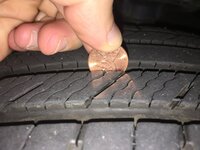Amazing car. Till date - ZERO problems. Not once did I have to go to the dealer to report a problem except on brakes which thankfully was resolved after cleaning the caliper pins. I have driven thru some extremely rough paved and un-paved roads but my OEM tires are still at 60% life! Recently checked my alignment and everything was still in GREEN.
Having used ONLY Mazda Moly I can safely say it's the best decision ever. Many times I am having to listen if the car's running, purrs like a cat.
There's ZERO body noise whatsoever. Those who says CX-5 is noisy I don't understand, but I own a 2016 where things were "worked upon" on this aspect ; heard 2017: even more!
Chassis bolts tightening - not much here in forums but surprisingly I have had to tighten them (front side) and it was about 3 to 4 turns of the bolt, I had to make!! That had a major impact on overall drive quality!
The preventive things I have done till date are the regular oil changes and I exclusively use the flexible schedule ONLY. For my 25,000 miles till date only 2 oil changes: 10k and 20k as and when the wrench thing came on and the flexible read: 25% life. Regular and on-time tire rotation + balancing done at Costco warehouse.
Although stated later - but I went ahead and changed both my cabin and air filters. When changing air filter, also inspected and cleaned the throttle plate/ air intake section and sprayed MAF cleaner on the MAF sensor. Mileage when done: 20k.
I have had zero issues with my Infotainment except unable to update (ever) the Gracenotes DB! My bluetooth connects, maps are responsive and from start - voice commands have been useless for me. I regularly update the firmwire and maps - myself.
This car has the best and most amazing head lights - they are super responsive and super bright.
Adaptive brakes has already saved me TWICE and once from being T-boned. I extensively utilize Adaptive Cruise control rain, clear, etc. and it has NEVER failed till date. I just simply love it.
Gripes - rear seat: no heating, no USB, no recline. For my children: they don't like the rear at all. My usual: Hate the fact there's no integrated traffic and the sound system: sucks!
Having used ONLY Mazda Moly I can safely say it's the best decision ever. Many times I am having to listen if the car's running, purrs like a cat.
There's ZERO body noise whatsoever. Those who says CX-5 is noisy I don't understand, but I own a 2016 where things were "worked upon" on this aspect ; heard 2017: even more!
Chassis bolts tightening - not much here in forums but surprisingly I have had to tighten them (front side) and it was about 3 to 4 turns of the bolt, I had to make!! That had a major impact on overall drive quality!
The preventive things I have done till date are the regular oil changes and I exclusively use the flexible schedule ONLY. For my 25,000 miles till date only 2 oil changes: 10k and 20k as and when the wrench thing came on and the flexible read: 25% life. Regular and on-time tire rotation + balancing done at Costco warehouse.
Although stated later - but I went ahead and changed both my cabin and air filters. When changing air filter, also inspected and cleaned the throttle plate/ air intake section and sprayed MAF cleaner on the MAF sensor. Mileage when done: 20k.
I have had zero issues with my Infotainment except unable to update (ever) the Gracenotes DB! My bluetooth connects, maps are responsive and from start - voice commands have been useless for me. I regularly update the firmwire and maps - myself.
This car has the best and most amazing head lights - they are super responsive and super bright.
Adaptive brakes has already saved me TWICE and once from being T-boned. I extensively utilize Adaptive Cruise control rain, clear, etc. and it has NEVER failed till date. I just simply love it.
Gripes - rear seat: no heating, no USB, no recline. For my children: they don't like the rear at all. My usual: Hate the fact there's no integrated traffic and the sound system: sucks!
Last edited:

